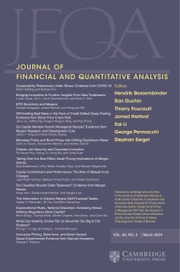No CrossRef data available.
Article contents
Institutional Cross-Ownership of Peer Firms and Revelatory Price Efficiency
Published online by Cambridge University Press: 12 August 2025
Abstract
We argue that cross-ownership increases the amount of private information in stock prices, enhancing the ability of stock prices to provide feedback to managers. Consistent with this argument, we find greater cross-ownership heightens a firm’s investment-q sensitivity. This effect is stronger for firms with a lower propensity for voluntary disclosure and for firms whose managers hold less private information. Furthermore, we find that cross-ownership is negatively associated with the sensitivity of a firm’s investment to its peers’ stock prices. Additionally, cross-ownership has a stronger impact on the investment-q sensitivity when measured among investors who trade more actively in the firm’s shares. By using financial institution mergers as an identification strategy, we strengthen the causal inference. Overall, our results suggest that cross-ownership helps increase revelatory price efficiency (RPE), potentially leading to more efficient corporate decisions.
Information
- Type
- Research Article
- Information
- Creative Commons
- This is an Open Access article, distributed under the terms of the Creative Commons Attribution licence (http://creativecommons.org/licenses/by/4.0), which permits unrestricted re-use, distribution and reproduction, provided the original article is properly cited.
- Copyright
- © The Author(s), 2025. Published by Cambridge University Press on behalf of the Michael G. Foster School of Business, University of Washington
Footnotes
We thank Weimian Ai, Philip Bond, Ran Duchin (the editor), Alex Edmans, Bjorn Jorgensen, Itay Goldstein, Joanna Wu, Shuai Xu, Yuan Zhang, an anonymous reviewer, and seminar participants at National Chengchi University, 2020 Cambridge Accounting Research Camp, the 2019 SOAR Accounting Research Summer Camp, and the 2023 European Accounting Association (EAA) Annual Congress for helpful comments and discussions. We gratefully acknowledge funding from the Lee Kong Chian Fellowship and the School of Accountancy Research Center (SOAR) at Singapore Management University.

